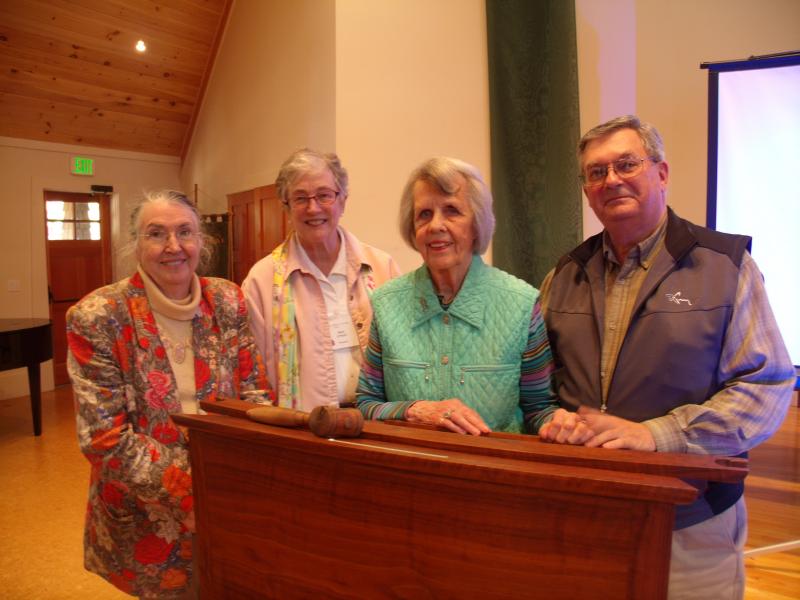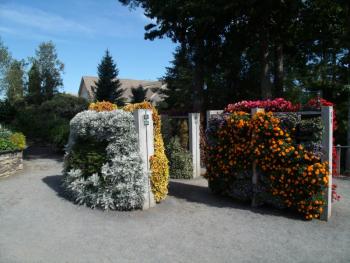On Wednesday, Oct. 12, the membership of the Boothbay Region Garden Club (BRGC) was pleased to welcome Wells and Mollie Moore who shared their intensely personal journey that lead to the development of what is touted as one of the very finest sensory gardens in the world. Mollie Moore is credited as the inspiration behind the Lerner Garden of the Five Senses which opened on June 19, 2009 at the Coastal Maine Botanical Gardens (CMBG).
Mollie, who lost her sight to pneumococcal meningitis literally overnight while vacationing in England in 2000, returned home to face the long climb back to some semblance of normalcy in her life. Her love of gardening, as evidenced by the fact that she and her husband were both volunteers and 1996 charter members of CMBG, was now challenged. How could she continue to enjoy the gardening experience without the sense of sight? A friend suggested they look into the sensory garden at the Brooklyn Botanical Gardens and that was the incentive Mollie needed to ask CMBG if they would consider creating such a garden --- one that could be experienced through all the senses and enjoyed by people with varying degrees of disability. The board granted the go ahead with the proviso that Wells and Mollie take the lead on the project.
After seven years of research, fundraising, consultation with design architects and garden professionals and lots of moral support, the sensory garden became a reality.
Wells and Mollie began their path to success by studying existing sensory gardens throughout the world including the Eden Project in Cornwall, United Kingdom, the Chicago and Brooklyn Botanical Gardens and the sensory garden in Oizumi Ryokuchi Park, Osaka, Japan. From those initial forays four guiding principles emerged: The garden should have universal accessibility, be a garden that could offer something for all, regardless of level of disability, be educational, and incorporate the ability to experience the garden through all five senses.
The Moores found much of their inspiration in the Osaka design. The embedded metal strips along a pathway to guide a cane walker, for example, were incorporated as a pathway lined with striker stones. Raised letters on signage, sculptures, a 3-dimensional map and voice technology, as well as bright contrasting colors and black and white checkering were also considered to aid the vision impaired. Signage using universal symbols and pictures were included to aid those with language or mental challenges.
Vertical and waist height planters with cut-aways below allow the wheelchair bound to get close enough to smell and touch without scrapping their knuckles, and extra wide walkways and resting areas with space for wheelchairs were also important features.
Design ideas were ultimately turned over to professionals to bring the project to fruition. As a result, the Garden of Five Senses offers all visitors a true sensory experience with heady scents and edible choices among the wide-ranging flowers, plants and herbs; tactile opportunities including everything from fuzzy petals and long slender leaves to sculptures, reliefs and pathways of varying composition; sounds that include rustling leaves, water spilling and splashing, birds and insects chirping and buzzing and even a place to hear one's own voice naturally amplified. And it all comes together in a visually pleasing landscape of nature and carefully planned architecture.
Mollie concluded the afternoon's talk by introducing the group to the Therapeutic Horticultural Program at the Lerner Garden of the Five Senses which began operating in 2009 under the tutelage of Irene Barber and allows those with varying levels of disability including VIPs (visually impaired people) to get their hands in the dirt to learn to grow flowers from seeds, dead head and prune plants, and dry herbs and flowers to make potpourri. According to Barber, people with conditions ranging from Down Syndrome to cerebral palsy, dementia, and autism have participated in the program and "receive clear instructions and gentle assistance and learn firsthand about the experience and process of working with plants. Their participation can help in stimulating cognitive activity, reducing stress levels, and encouraging social interaction."
At the end of their presentation Mollie said of the Five Senses Garden that it is "perhaps the best sensory garden in the United States," and who would know this better than she?
Visit http://landscapeonline.com/research/article.php/15158 for detailed information on the Garden of Five Senses and http://www.uniquemainefarms.com/uniquemainefarms.com/Coastal_Maine_Botan... to learn more about the Therapeutic Horticultural Program.
The Boothbay Region Garden Club takes pride in promoting programs that benefit our membership and the community at large. For more information on what the Boothbay Region Garden Club is doing check out www.boothbayregiongardenclub.org/. BRGC is affiliated with National Garden Club, Inc. (NGC) and is a member of the Garden Club Federation of Maine (GCFM ).
































